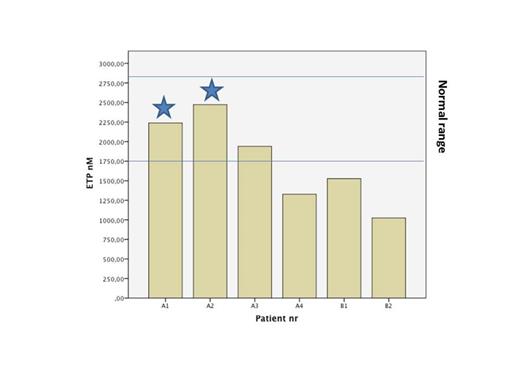Abstract
MYH-9 related platelet disorders are inherited macrothrombocytopenias. Before the genetic cause was identified, four overlapping syndromes (May-Hegglin, Epstein, Fechtnerand Sebastian syndrome) described the additional clinical manifestations in MYH-9 disorders including renal failure, hearing loss, pre senile cataract and inclusion bodies in leucocytes that are present in different combinations. The MYH-9-gene codes for the cytoplasmic contractile protein non muscular myosin heavy chain IIA, present in several tissues, which explains the additional symptoms. The bleeding tendency is usually mild to moderate but rarely, thrombotic complications are also seen (1). We report on the thrombin generation potential (ETP) in MYH9 patients with and without arterial thrombosis.
In the first family (family A) 4 members were evaluated: a 51 year old woman (platelet count 36), her 24 year old daughter (platelet count 46), and the brother of the woman (57 years; platelet count 39) and his 30 year old son (platelet count 44). All four were affected by MYH-9 disorder with macrothrombocytopenia and inclusion bodies in the leucocytes and a 5521G>A mutation, causing Glu1841Lys. 3 of them had a moderate bleeding tendency [ISTH /SSC bleeding scores 9, 13, 4 where <4 is normal) (3)] and in the 51 year old women and her brother, renal insufficiency and hearing loss were already present. Both patients had an arterial thrombosis (myocardial infarction and pons infarction respectively) before 50 year of age. Both showed hyperlipidemia and hyperhomocysteinemia. In the second family (Family B) macrothrombocytopenia and small to medium size inclusion bodies in the leucocytes were found in the mother (38 years; platelet count 36) and the daughter (age15 years, platelet count 46) caused by a c. 4679 T>G mutation resulting in p.Val1560Gly. Their bleeding tendency was mild (bleeding scores 4 and 3 respectively). Thrombelastography (ROTEM) was normal in all five individuals. ETP was seen to be below the normal range in family B. However, in family A, the two members affected by thrombosis had a normal ETP (Fig 1), indicating that other factors compensated for the low platelet count and clinically even led to a breakthrough of arterial thrombosis despite the low platelet count. We suggest that other centers also assess the ETP in their MYH-9 patients according tour protocol to gather data on the potential association of the ETP with the phenotype.
References
Althaus K, Greinacher A: MYH-9 Related Platelet Disorders: Strategies for Management and Diagnosis. Transfus Med Hemother. 2010 October; 37(5): 260–267.
Girolami A , Vettore S, Bonamigo E, Fabris F: Thrombotic events in MYH9 gene-related autosomal macrothrombocytopenias (old May–Hegglin, Sebastian, Fechtner and Epstein syndromes) J Thromb Thrombolysis. 2011 Nov;32(4):474-73.
Rodeghiero F, Tosetto A, Abshire T et al.; ISTH/SSC Joint VWF and Perinatal/Pediatric Hemostasis Subcommittees Working Group. ISTH/SSC bleeding assessmenttool: a standardizedquestionnaire and a proposal for a newbleedingscore for inherited bleeding disorders. J Thromb Haemost 2010; 8: 2063–5.
Endogenous thrombin potential in two families with MYH-9 related disease
Thrombin generation was performed on frozen platelet rich plasma on 5 members from two different families (family A and B) with MYH-9 related disease. Two members in the first family (A:1 and A:2) had a previous arterial thrombosis (pons infarction and myocardial infarction, respectively, marked with a star).
No relevant conflicts of interest to declare.
Author notes
Asterisk with author names denotes non-ASH members.


This feature is available to Subscribers Only
Sign In or Create an Account Close Modal